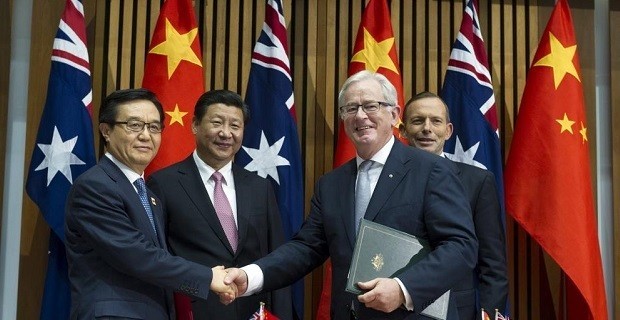Will ChAFTA be a Catalyst for Chinese Investment Capital into Australia?

The China-Australia Free Trade Agreement (ChAFTA) is likely to have significant consequences in the local property markets, especially for those cities in Australia going through a period of strong demand.
A hugely increased threshold in permissible Chinese investment into property looks set to create a situation of excess land banking, which will have far-reaching implications for everything from pricing to competitiveness and even significant impact in terms of infrastructure. In short, what we are going to see is that there will be a significant injection of Chinese investment capital into Australia.
Under the terms of the ChAFTA, the screening level for Chinese investors buying commercial property has increased from $248 million to $1.078 billion. Australia was already seen as an attractive opportunity to invest for multiple reasons:
- Chinese investors could earn a Significant Investor Visa by investing more than $5 million in the market;
- Low interest rates make borrowing from local banks easier and this has been reinforced by the Reserve Bank of Australia (RBA)’s lowering of the interest rate to a new record low of 2.25%;
- The weaker dollar is making investment cheaper;
- The continued opinion by the international community that the local economy in Australia is stable.
There are also lifestyle factors that are driving Chinese investors to Australia, such as the favourable climate, excellent educational resources for children and a more convenient time difference between Australia and China than between other trade countries like America.
Australia is already in the top three destinations for Chinese property buyers, coming third behind the US and the UK, and within that Sydney has been the key market. However challenges in acquiring land in Sydney during the recent property surge has also led the Chinese to look to Melbourne and Brisbane. And the easing of restrictions for investment purposes is only going to help Australia grow as a destination for property investment.
There is the argument that increased interest in the local market from Chinese investors will help ease housing shortages in numerous areas with cities on the eastern seaboard. However in practice we expect the opposite effect to be true. Development sites are notoriously difficult to find at the moment and if Chinese developers take advantage of the increased threshold of the ChAFTA then we’re going to see significant short- and long-term implications. This is especially true given that in many cases Chinese investors are paying excessive amounts for land, but are not in any particular hurry to develop them (a practice known as land banking).
In the short term, these investments may act as a curb on an oversupply of generic units in the larger cities (specifically Sydney and Melbourne). A good example of this would be an area like Mascot in Sydney, where the investors will lock up sites that otherwise would have been developed and sold off by local developers.
In the longer term, the increased threshold will mean it is possible that significant areas of these markets will be concentrated in relatively few hands. When that happens, they’ll be able to control the supply of medium to high density sites, which will in turn enable them to demand inflated prices.
This will also have a flow-on effect on our infrastructure, which is already struggling in parts of the major cities. Long-term land banking makes it difficult for the government to work adequately with developers to provide the necessary infrastructure to support these areas.
However …
The risks that face Australia’s property markets from Chinese investment under the ChAFTA are important to note. However it’s not a universal concern and there are benefits to consider as well. Regulations still limit Chinese investors from buying established properties (a Chinese individual might purchase an established property to live in while in Australia, but it would need to be sold once they return home), so the ChAFTA investment opportunities apply specifically to new properties.
And Chinese investment in Australian property still remains a small percentage of the property investment market. There was a sharp jump in foreign investments into property in 2013-2014, but overall foreign investment still accounts for just 12-13% of all sales and one-tenth of that was from China. To give these amounts some context, China’s investment in Australia has typically been around the levels of investment from the United Kingdom and far behind America. It can be expected that the ChAFTA will close that gap, but it remains true that foreign investment is localised into specific areas within targeted locations.
And finally, while it is undeniable that there is land banking going on, there are also signs that the larger Chinese investment groups – the ones seeking residential development projects of 500 apartments or more – are being rolled out in 2015. There are developer teams and offices being established and with the new opportunities that ChAFTA is offering Chinese investors these are naturally going to take some time to adequately resource.
As these projects are undertaken and completed, the increased housing supply will help to restrain price growth, regardless of whether they are developed through domestic or foreign investment. A report from the Australian Housing and Urban Research Institute found that a leading cause of the undersupply of housing in Australia is the availability of local finance, with banks demanding pre-sales before construction begins of anything up to 100% of the value of the loan. The increase of foreign investment will have the effect of easing the growth of demand-induced price pressure.
So, while the ChAFTA can be expected to result in an increase in Chinese investment capital into Australia and while this will have a significant impact on some areas within key markets in Australia, the effect will only be to specific, localised areas within those markets. And equally, it will bring benefits into the market that benefit local developers as well.
This article was provided by Chris Curtis of Curtis Associates. Curtis Associates is an independent and licensed buyers’ agent located in the Sydney CBD. Chris offers expert commentary on Sydney property market sought by ABC, The Australian Financial Review, The Australian, Sydney Morning Herald and Moody’s Economy.com. This article can be republished with attribution under a Creative Commons Licence.





